The Huawei P8 Review
by Andrei Frumusanu on June 4, 2015 8:00 AM EST- Posted in
- Smartphones
- Huawei
- Mobile
- P8
- Kirin 930
Display Measurement
Continuing on to the display, we find a JDI manufacured 5.2" IPS-Neo screen together with a NovaTek NT35695 display controller IC that also saw use in various devices among also the HTC One M8. IPS-Neo promises increased contrast ratio over traditional IPS displays, and we've already confirmed this claim in the Huawei Mate 7 which also used a similar type of display.
As always, our display testing is done with an X-Rite i1Pro 2 spectrophotometer as our measurement hardware, in conjunction with SpectraCal's CalMAN software suite and our own workflow to be able to get an accurate display characterization.
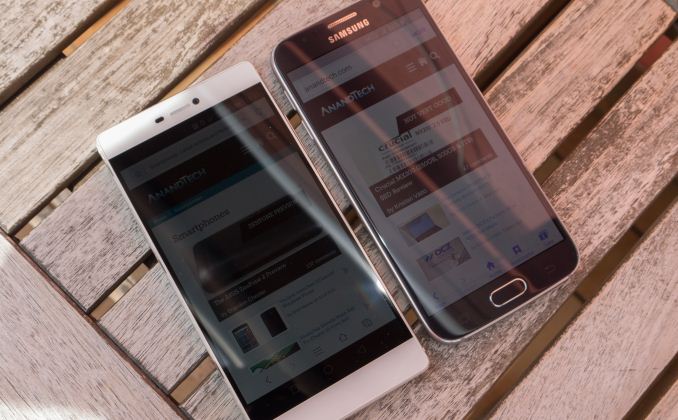
Huawei P8 and Samsung Galaxy S6 in direct sunlight
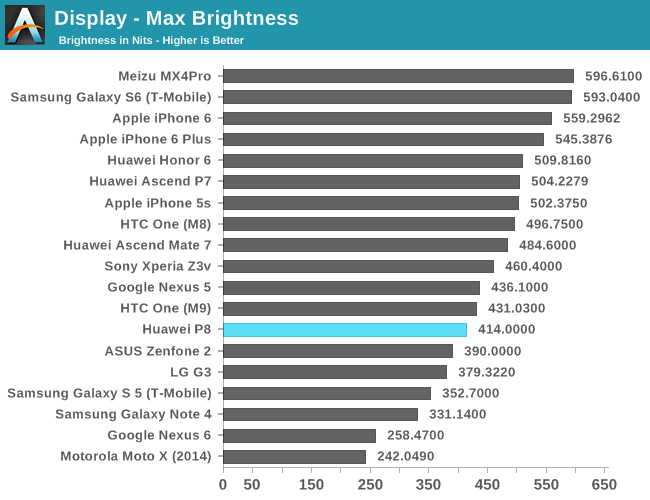
We start off with the maximum brightness of the display: The P8 seems to exhibit itself as one of the more dim LCD devices as it doesn't exceed the 414 cd/cm² mark. Readability on a bright day isn't too fantastic, but still very usable as long as the sun doesn't directly shine on the display.
I noticed a very weird behaviour of the display's brightness that cannot be explained by usual mechanisms such as CABC. The OS clearly alters brightness depending on the application - for example using a browser such as the stock one or Chrome, along with other random applications such as Dropbox or FX Explorer will cause a dimming in the display, if one opens up the recents menu or goes back to the home-screen then one can see how the backlight brightens up. One would think this can be explained with by assuming the default launcher and OS elements are allowed a higher luminosity than other apps, but I've discovered that many other apps don't dim the display.
Huawei's luminance steps are also far from even - there is a noticeable sudden jump from around 200 nits to 350 nits without any inbetween levels. While this poses no real practical issue, it's odd to not see smooth brightness adjustments on a modern flagship such as the P8.
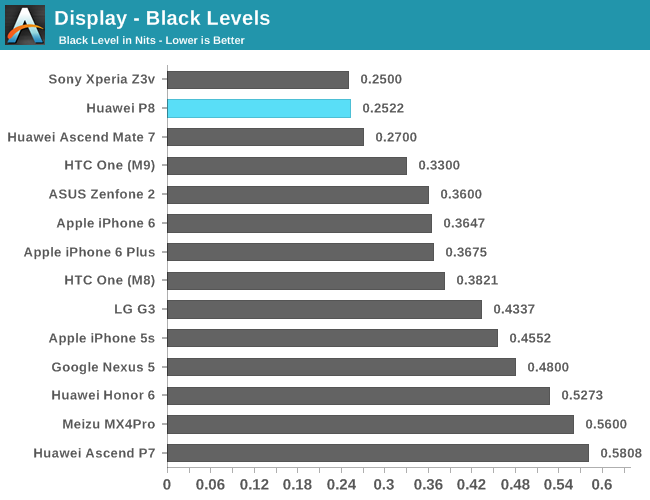
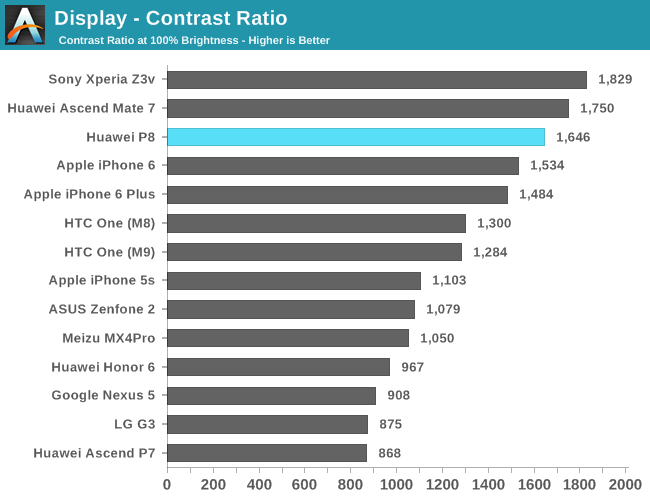
When looking at the black levels, we see the clear advantage of the IPS-Neo technology as the two devices sporting the panels are ahead of other LCD alternatives. As a remark on the graphs: The Sony Z3v makes use of CABC to achieve its high dynamic contrast ratio, as such it doesn't represent the true contrast of the display panel. As the P8 and Mate7 do not employ any APL-dependent brightness controls, they show the panel's true strength.
At maximum brightness, the P8 reaches a contrast ratio of 1646:1, a tad over the 1500:1 that Huawei advertises in its marketing materials. It's on medium brightness though that the display shines, as we see a contrast ratio going up to 2827:1 at 200 cd/cm², as blacks get darker the further away one is from the maximum panel brightness.
The P8 dissapointingly offers no super-low minimum brightness for late-night usage, as it bottoms out at around 10.5 nits, higher than the ~2 nits we've seen vendors like Samsung or Meizu achieve.
The unit we've received from the London launch event suffered from a very bad case of backlight bleeding. This was especially visible in the bottom left corner of the device where one would notice the uneven luminosity even in normal applications, and this was exacerbated by the fact that the navigation bar has a black background. I suspect this is a build-quality issue, as, funnily enough, squeezing on the frame and edges around the display will actually diminish the backlight-bleed for some time until slowly it reverts back to a state similar as captured in the above photograph.
Before we continue on with display accuracy measurements, I want to take a moment to explain Huawei's temperature control mechanism integrated in the OS's system settings. Huawei has long had this feature implemented in previous devices, and we covered it in the Mate 7 review. Choosing the warmest temperature on that device resulted in a mess of a display with a green-dominated white at 6073K, making that setting utterly unusable. The P8 differs strongly from these older devices by offering an excellent calibration when setting the colour temperature slider to the warmest possible value. As this slider offers no discrete setting other than the minimum, default and maximum values, it was previously unreasonable to try to hit a reproducible "accurate" setting. With the P8 now offering this accurate "mode" straight out of the box on the minimum setting, we see it as an equivalent to the "Movie"/"Basic" display modes on Samsung devices, and will thus use it as the de-facto measurement point for display accuracy in this review. For comparison's sake, we also show the "default" setting with which the devices comes set up.
Warmest Colour Temperature
Default Temperature
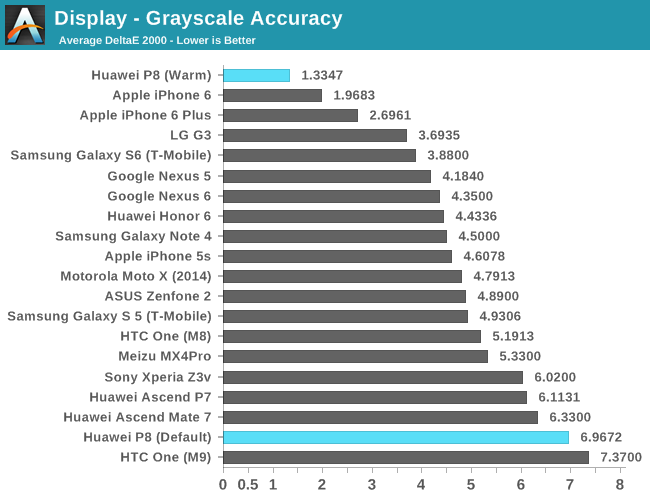
Having cleared up the colour temperature settings and explained how Huawei chooses to expose it to the user, we can see some outstanding results in our grayscale accuracy measurement. The P8 manages to achieve an outstanding deltaE2000 of 1.3347, putting it far ahead of many devices, including Apple's iPhones. Staying on the default colour temperature on the other hand makes the grayscale accuracy degrade from the best to one of the worst devices in our benchmarking database, reaching a deltaE2000 of 6.96.
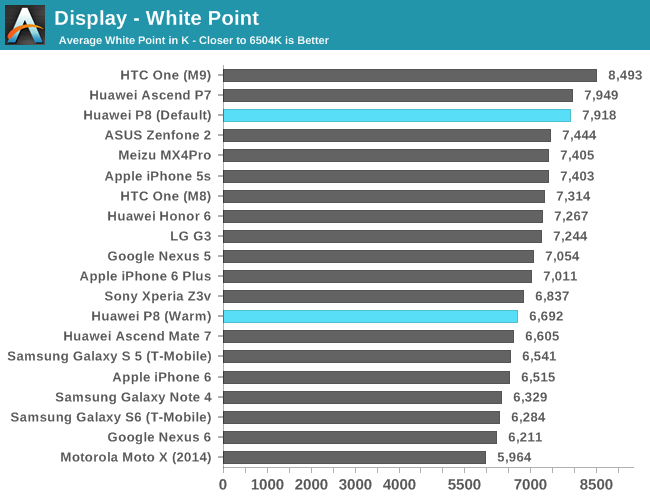

While the altered colour temperature settings helps the P8 achieve a better saturation accuracy metric of deltaE2000 of 2.180 instead of 4.8764, it doesn't match up to the performance we saw in the grayscale accuracy test. The P8's gamut remains too large and veers off from the sRGB targets in the blue and green spectrums.
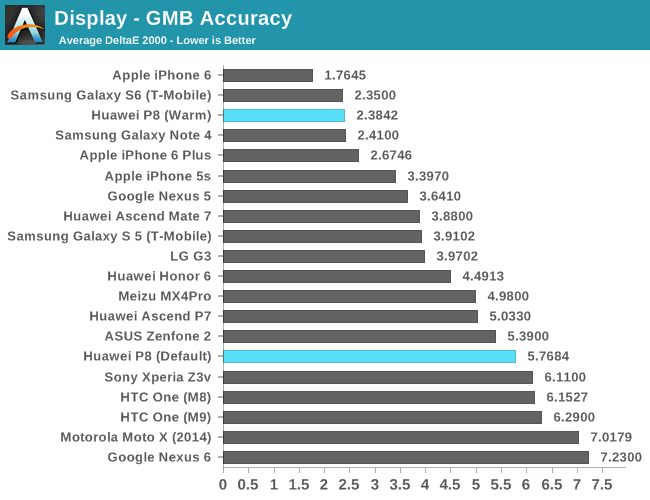
In the GretagMacBeth test we see the P8 perform very well with a dE2000 of 2.3842 (And naturally, a much worse dE2000 of 5.76 on the default settings).
Overall, the verdict on the P8's screen is a bag of mixed feelings. If I hadn't tested the colour temperature slider this would have easily been a very straightforward conclusion to write. The average brightness range of the display together with the problematic uneven backlight and bad viewing angles would have been enough to deem this as one of the worst displays of this year when tested under the default settings. Fortunately for Huawei they pulled an unexpected rabbit out of a hat and delivered some quite excellent numbers on colour accuracy.
I'm not sure if Huawei implemented this on purpose, or it's a one-off coincidence, but I hope the company continues to offer a calibrated baseline which is easily selectable, through the colour temperature slider or other means such as display profiles. In the end, it's up to the end-consumer to decide what aspect is more important to them as we weigh out the pros and cons of the display.
Display Power
Measuring the device's luminance-power curve is can be a very useful tool to analyze and estimate the power efficiency of not only the screen, but also the internal components of the device. Althrough I didn't dare to completely dismantle the P8 to get hard readouts through an external power supply, I did manage to fiddle around with the internal fuel-gauge to be able to get some clean numbers that hopefully get near the real thing.
First off, we can see that the P8 is able to reach quite good results at minimum brightness, going down to about 508mW at 10.6 cd/cm². We saw similar data-points from the Meizu MX4Pro which reached down to 530mW at minimum brightness, and the Note 4 which can go down to 440mW on a black screen. The P8 performs well here and points out to good idle power-management and to the inclusion of Panel-Self-Refresh (PSR) through the NovaTek display controller IC.
The maximum power can reach up to 1373mW, and if we substract the idle power from that figure we reach a luminance power load of about 870mW for 433nits, which is in the ballpark of other LCD devices, but for example loses out in efficiency by 100mW at the same brightness when compared to the slightly larger screen of the MX4Pro. Looking at the 200nits point then again fares better for the P8 as it wins with around 340mW versus 356mW for the Meizu, pointing out to different scaling in luminance-power between the two screen technologies.


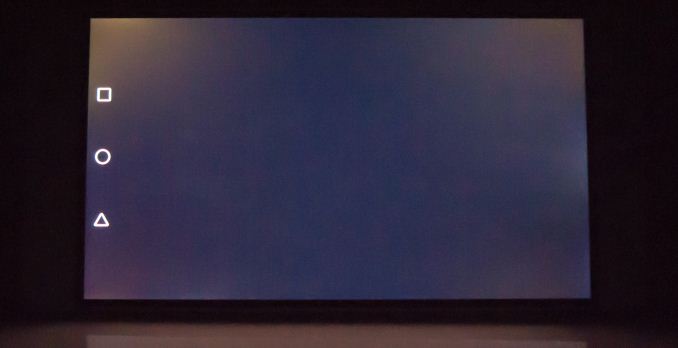

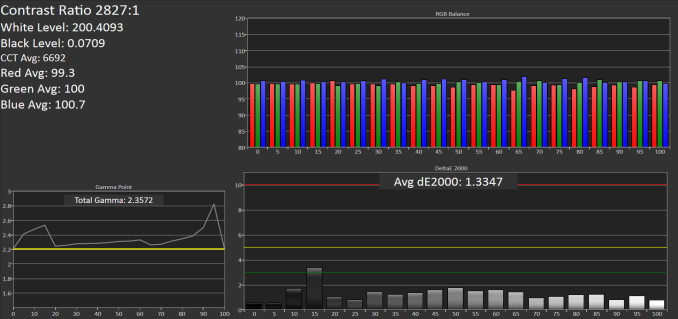

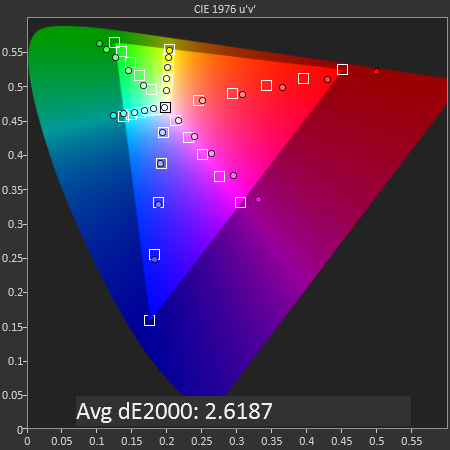


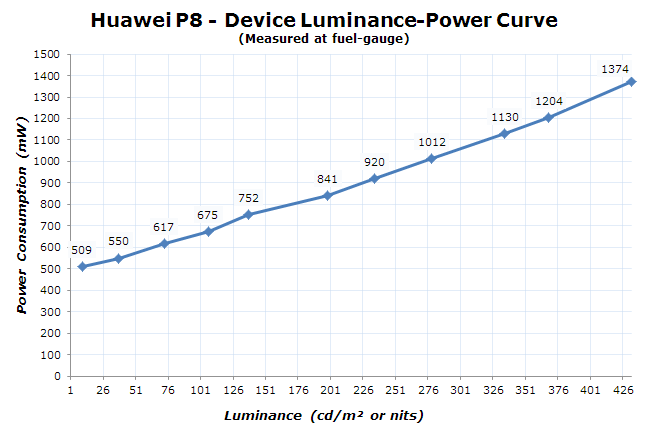








104 Comments
View All Comments
hrrmph - Thursday, June 4, 2015 - link
It's probably more useful than an iPhone for people who travel a lot and occasionally go off the grid, and thus need the device to still work as a GPS, camera, miniature computer, etc, while drawing all data from fast, convenient local storage...- It has a MicroSDXC slot, so it can take the new 200GB MicroSD storage cards; and
- It has dual SIMS.
Unfortunately, it lacks a user removable battery, so it is still inferior in that regard to each of the phones and phablets that I already have. But, in general, I like what they are doing.
Something that other nationals can tend to forget is that China has a lot of wealthy people (far more than the US or possibly even Europe). Even though these elite Chinese are wealthy, many of them are shrewd spenders. They want value for their high-end spend. So there is a lot of pressure on Chinese vendors to produce high-end devices that include every possible feature.
So just like Japanese enthusiasts used to get certain stereos and cameras that America only dreamed of, the Chinese are demanding that the manufacturers provide more fully functional high-end phones that can do everything... including the things that the iPhone cannot do.
That said, the iPhone is making headway in China too...
... but just like in the US, it's for all the wrong reasons. Namely, it's a jewelry piece that holds sway as a status symbol amongst the more vacuous of minds. Owning one supposedly elevates your perceived social status - much in the way that owning a ludicrously expensive sports car or ultra-luxury car does the same (think Rolls-Royce, Bentley, etc.).
Sociologists and psychologists have hypothesized that such objects are attractive to both the buyers who display them publicly and to those who view them, particularly the opposite sex.
People who buy these objects are subliminally advertising to potential mates that they have excess money that (under the proper circumstances) can in the future be re-directed to caring and tending for children and non-working spouses.
The attraction effect is generally stronger if the object is purchased and displayed by a male, because many societies still expect the male to bear the larger burden of providing financial resources. This is especially the case while the female is pregnant and in the early years of caring for children that aren't yet school aged.
The larger the excess spend over the practical value, the higher the perception of excess earning capacity. That's why we sometimes see phones sold with precious jewels encrusting them. Apple is just doing the same thing on a lower level... right out of the box. Charging more than the inherent underlying value.
So it's rather refreshing to see the Chinese manufacturers taking a different approach.
And it is especially refreshing to see the Chinese doing this in light of the fact that Samsung vacated the market as an Apple competitor and have now lowered themselves to merely matching Apple's product features. Without the Chinese, the Apple-Samsung twins (newly conjoined) don't really have any competition. The Chinese upping their game changes things.
Of course Apple can play this game too if they want. They simply need to offer more than 264GB of storage. The P8's 64GB of onboard NAND storage combined with the new SanDisk 200GB Micro-SDXC storage card will now set a very high bar that Apple needs to try to hurdle over (if Apple wants to be taken seriously with regard to storage).
I'm thinking that if Apple offers its next phone with 512GB of storage then that would safely secure the storage crown for them (remember, Samsung used to regularly double Apple's storage by simply adding a Micro-SD slot, but Samsung has now given up on competing).
Then Apple would need to add Dual-SIM slots to improve connectivity and travelability. It may come as a surprise to the uninformed that the newly wealthy Chinese (like many other nationals) are joining the tourist-corps. They are world travelers and they want their phones to work anywhere that they are likely to travel. Having Dual-SIMs makes it both convenient and affordable (roaming data charges are still the bane of the planet, even for wealthy Chinese).
I would also argue that to be better than what I've personally already got (and most Chinese, other Asians, Middle-Easterners, Africans, and Europeans already have), Apple would need to offer user removable back covers and batteries. Nothing says "I can handle a thirty hour multiple segment, multi-modal (air, sea, and land) journey" than a couple of lightweight fully-charged spare batteries. No awkward cables... just plop in and play on like nobody's watching.
So the Chinese phones are Apple clones? Nahh, this is just the Chinese practicing for the end-game. They want to do what Samsung used to regularly do to Apple: offer the consumer more for less... and the Chinese have just proven that they can win the storage crown. So who is to say they won't eventually win the various other races to provide the best-of-the-best on the other features? All it requires is Apple-Sung to remain lazy… which is something they have lately proven to be very adept at.
pityko - Thursday, June 4, 2015 - link
I signed up just to be able to thank you for this comment. You brilliantly summarised everything that's wrong with the current "leaders" of the mobile phone industry. I've been a Samsung user for years after being disappointed by the iPhone 3G then HTC in general but now when my contract expires for my Note 3 I am leaving for a Chinese brand, I want to support a company that hasn't given up trying.pgari - Thursday, June 4, 2015 - link
Always surprises me how people in these blogs write about what Apple "should do", but for what? To be even more successful? What are their credentials?Of course, anyone can say what they like or dislike. But the implicit assumption in most of these comments is "I know better", which is, at the least, presumptuous
Rod_Serling_Lives - Friday, June 5, 2015 - link
Well said. Apple already dominates with only a handful of devices and I don't know if they could be in a better position than they are currently.nathanddrews - Friday, June 5, 2015 - link
Personally, I don't like anything about Apple except the build quality of most of its products and its stock price. Cha-ching! I don't buy Apple products or use Apple software, but I'm happy the corporation is so successful. Deep down inside, I find myself horribly judging and mocking consumers of Apple products, but then I just have to remind myself not to feel bad about it. They're already dead inside.;-)
Brakken - Friday, June 5, 2015 - link
I think it's Tall Poppy syndrome... even ignoring everything else Apple has pioneered over the years and just looking at the Apple Watch - first gen of hardware and software, and it's amazingly smooth and will have years of support and development. With the hardware makers for Android, they are all dropping support for SD cards and removable batteries, except LG (?), but no one seems to talk about it when it happens. I think people start making 'I know better' statements because they don't check history.MarcSP - Saturday, June 6, 2015 - link
I agree with many of the things you said, but your theory about iphone as a status symbol is incomplete. I mean, according to what you said it seems that most buyers should be single men, and I have seen as many women as men with iPhone in Shanghai (maybe more, as female tend to follow fashion very strongly, and most cannot choose a phone based on "tech" or "features").Also, many married couples and middle aged and old persons use iPhone. Even students have them.
It always strikes me, because in China iPhone's price is quite higher than the average salary in the first tier cities. Imagine if an iPhone cost 2000 USD in the US. Nobody would buy it, but in china they do.
I guess mostly because the "status symbol" thing, but not to impress potential sexual partners, just to say "hey, look, I am NOT POOR", even if you are and cannot afford a health insurance and use recycled oil for cooking. After the communist times, Chinese socity has gone to the other extreme. Now being poor is not just pityful, it is shameful. No matter how, even if you have to sell tainted milk to babies or steal from your fellow citizens with lies, you MUST become rich. Of course, most cannot, so that's why they think having a "symbol" is better than nothing. "Appearence" is king nowadays in China, not "substance". I guess they need 20 more years to find a balance. Too many changes, too fast.
Ethos Evoss - Friday, June 12, 2015 - link
jesu su writing a book ?jjj - Thursday, June 4, 2015 - link
You wish the iphone had a sane design like this instead of their roadkill look.puremind - Thursday, June 4, 2015 - link
If Apple had cloned this device, it would have been better. Instead of the huge bezels it would have had a much more usable form factor.